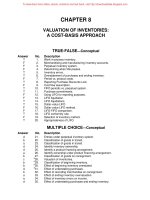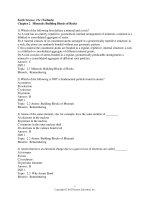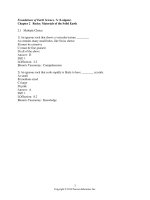Test bank earth science 12e ch9
Bạn đang xem bản rút gọn của tài liệu. Xem và tải ngay bản đầy đủ của tài liệu tại đây (68.85 KB, 13 trang )
Earth Science, 13e (Tarbuck)
Chapter 9 Volcanoes and Other Igneous Activity
1) In 1980, ________ was the first Cascade Range volcano to erupt since Mt. Lassen in 1915-16.
A) Mt. Rainier
B) Mt. Shasta
C) Kilauea
D) Mt. St. Helens
Answer: D
Diff: 1
Topic: 9.1 Mt. St. Helens Versus Kilauea
Bloom's: Remembering
2) Which type of basaltic lava flow has a fairly smooth, unfragmented, ropy surface?
A) aa
B) pegmatitic
C) pahoehoe
D) scoria
Answer: C
Diff: 1
Topic: 9.3 Materials Extruded During an Eruption
Bloom's: Remembering
3) ________ is a major dissolved volatile constituent in both magmas and volcanic gases.
A) Water
B) Carbon monoxide
C) Hydrogen chloride
D) Methane
Answer: A
Diff: 1
Topic: 9.2 The Nature of Volcanic Eruptions
Bloom's: Remembering
4) Volcanic bombs originate ________.
A) as laser-guided, granite blocks launched from a supersonic jet
B) as blocks of volcanic rock ejected from an erupting volcanic crater
C) as erupted magma blobs that partly congeal before falling to the ground
D) as ash particles that join together in the eruptive plume and fall as cobble-sized objects
Answer: C
Diff: 1
Topic: 9.3 Materials Extruded During an Eruption
Bloom's: Remembering
1
Copyright © 2012 Pearson Education, Inc.
5) ________ magma is the most abundant type erupted on Earth.
A) Basaltic
B) Granitic
C) Andesitic
D) Pegmatitic
Answer: A
Diff: 1
Topic: 9.3 Materials Extruded During an Eruption
Bloom's: Remembering
6) The ________ ocean basin is rimmed by the most subduction zones.
A) Atlantic
B) Indian
C) Pacific
D) Arctic
Answer: C
Diff: 1
Topic: 9.4 Volcanic Structures and Eruptive Styles
Bloom's: Remembering
7) Which of the following factors help determine whether a volcanic eruption will be violent or
relatively quiescent?
A) amount of dissolved gas in the magma
B) temperature of the magma
C) composition of the magma
D) all of these
Answer: D
Diff: 1
Topic: 9.2 The Nature of Volcanic Eruptions
Bloom's: Remembering
8) Cinder cones ________.
A) have very steep slopes
B) are usually less than 300 meters (1000 feet) high
C) consist largely of pyroclastics
D) all of these
Answer: D
Diff: 1
Topic: 9.4 Volcanic Structures and Eruptive Styles
Bloom's: Remembering
2
Copyright © 2012 Pearson Education, Inc.
9) The Columbia Plateau in the northwestern United States is an excellent example of ________.
A) silica-rich lava flows
B) pyroclastic flow deposits
C) flood basalts
D) an eroded shield volcano
Answer: C
Diff: 2
Topic: 9.6 Other Volcanic Landforms
Bloom's: Applying
10) Kilauea is an example of a ________.
A) shield volcano
B) cinder cone
C) lava dome
D) volcanic neck
Answer: A
Diff: 1
Topic: 9.4 Volcanic Structures and Eruptive Styles
Bloom's: Applying
11) ________ are usually the most abundant gases emitted during basaltic volcanism.
A) Chlorine and sodium
B) Neon and ammonia
C) Oxygen and nitrogen
D) Water and carbon dioxide
Answer: D
Diff: 1
Topic: 9.3 Materials Extruded During an Eruption
Bloom's: Remembering
12) Paricutin is an example of a ________.
A) shield volcano
B) cinder cone
C) lava dome
D) composite volcano
Answer: B
Diff: 1
Topic: 9.4 Volcanic Structures and Eruptive Styles
Bloom's: Remembering
3
Copyright © 2012 Pearson Education, Inc.
13) Mount Pelée on Martinique is an example of a ________.
A) shield volcano
B) cinder cone
C) lava dome
D) composite volcano
Answer: D
Diff: 1
Topic: 9.5 Living in the Shadow of a Composite Cone
Bloom's: Remembering
Give the term that best answers each phrase.
shield volcanoes
composite/stratovolcanoes
cinder cones
14) massive, gently sloping volcanoes built of successive, basaltic lava flows
Answer: shield volcanoes
Diff: 1
Topic: 9.4 Volcanic Structures and Eruptive Styles
Bloom's: Analyzing
15) large, fairly steep-sided cones composed of lavas and pyroclastic layers
Answer: composite/stratovolcanoes
Diff: 1
Topic: 9.4 Volcanic Structures and Eruptive Styles
Bloom's: Analyzing
16) small basaltic cones built during one short, eruptive episode
Answer: cinder cones
Diff: 1
Topic: 9.4 Volcanic Structures and Eruptive Styles
Bloom's: Analyzing
17) the volcanoes of southwestern Alaska and the Aleutian Islands
Answer: composite/stratovolcanoes
Diff: 1
Topic: 9.4 Volcanic Structures and Eruptive Styles
Bloom's: Analyzing
18) the big volcanoes of Hawaii
Answer: shield volcanoes
Diff: 1
Topic: 9.4 Volcanic Structures and Eruptive Styles
Bloom's: Analyzing
4
Copyright © 2012 Pearson Education, Inc.
19) Which statement about the May, 1980, eruption of Mount St. Helens is false?
A) During the eruptive period, the mountain peak was substantially built up by new lava flows
and pyroclastic debris.
B) Plumes of ash rose high into the atmosphere during the major eruptive events.
C) Mudflows accompanied the major eruptive events.
D) The most powerful explosive event was preceded by a massive landslide.
Answer: A
Diff: 1
Topic: 9.1 Mt. St. Helens Versus Kilauea
Bloom's: Applying
20) ________ tend to increase the explosive potential of a magma body beneath a volcano.
A) High viscosity and dissolved gas
B) High viscosity, low dissolved gas content
C) Low silica content, low viscosity
D) Low viscosity, low dissolved gas content
Answer: A
Diff: 1
Topic: 9.2 The Nature of Volcanic Eruptions
Bloom's: Analyzing
21) Which type of basaltic lava flow has its surface covered with sharp-edged, angular blocks
and rubble?
A) scoria
B) pahoehoe
C) pillow lava
D) aa
Answer: D
Diff: 1
Topic: 9.3 Materials Extruded During an Eruption
Bloom's: Remembering
22) Which one of the following statements concerning volcanic blocks and bombs is true?
A) Blocks are broken fragments of solid rocks; bombs have smaller sizes than lapilli.
B) Bombs are guided to Earth by laser beams; blocks fall anywhere.
C) Bombs are ejected as magma lumps; blocks are ejected as solid fragments.
D) Bombs and blocks are both smaller than lapilli and cinders.
Answer: C
Diff: 1
Topic: 9.3 Materials Extruded During an Eruption
Bloom's: Remembering
5
Copyright © 2012 Pearson Education, Inc.
23) ________ destroyed the city of St. Pierre, Martinique, in 1902.
A) Mudflows
B) Basaltic lava flows
C) Heavy ashfall
D) A nueé ardente
Answer: D
Diff: 1
Topic: 9.5 Living in the Shadow of a Composite Cone
Bloom's: Remembering
24) Which one of the following statements concerning cinder cones is false?
A) They are small volcanoes with fairly steep sides.
B) They are built mostly or entirely during one eruptive cycle.
C) The cinders and other pyroclastic particles are consolidated into welded tuff.
D) The cinders most commonly are basaltic.
Answer: C
Diff: 1
Topic: 9.4 Volcanic Structures and Eruptive Styles
Bloom's: Analyzing
25) Spreading center volcanism most generally produces rocks that are ________.
A) granitic in composition
B) basaltic in composition
C) rhyolitic in composition
D) ultramafic in composition
Answer: B
Diff: 1
Topic: 9.9 Plate Tectonics and Volcanic Activity
Bloom's: Remembering
26) Which kind of eruptive activity is most likely to be highly explosive?
A) lava flows from a large shield volcano on an oceanic island
B) fissure eruptions feeding lava to flood basalt accumulations
C) eruptions of big, continental margin, composite cones or stratovolcanoes
D) lava flows from a large cinder cone complex
Answer: C
Diff: 1
Topic: 9.4 Volcanic Structures and Eruptive Styles
Bloom's: Remembering
6
Copyright © 2012 Pearson Education, Inc.
27) Magma tends to rise toward Earth's surface principally because ________.
A) water is an abundant constituent of magma
B) silica is abundant in magma
C) magma is a fluid
D) rocks become less dense when they melt
Answer: D
Diff: 1
Topic: 9.9 Plate Tectonics and Volcanic Activity and 9.8: The Origin of Magma
Bloom's: Analyzing
28) Kilauea and Mauna Loa are ________.
A) explosive, rhyolitic volcanoes
B) andesitic stratovolcanoes
C) basaltic shield volcanoes
D) small, basaltic cinder cones
Answer: C
Diff: 1
Topic: 9.4 Volcanic Structures and Eruptive Styles
Bloom's: Applying
29) Mount St. Helens is ________.
A) a basaltic cinder cone
B) an explosive stratovolcano
C) a basaltic shield volcano
D) a small, welded tuff cone
Answer: B
Diff: 1
Topic: 9.4 Volcanic Structures and Eruptive Styles
Bloom's: Applying
30) The 1943 eruption of Paricutin in Mexico was characterized by ________.
A) mudflows and explosive ash eruptions
B) welded-tuff deposition and caldera formation
C) cinder cone building and basaltic lava
D) pyroclastic eruptions and nueé ardente flows
Answer: C
Diff: 1
Topic: 9.4 Volcanic Structures and Eruptive Styles
Bloom's: Applying
7
Copyright © 2012 Pearson Education, Inc.
31) The average composition of rocks comprising a large composite cone or stratovolcano is
similar to a(n) ________ magma.
A) basaltic
B) ultramafic
C) andesitic
D) rhyolitic
Answer: C
Diff: 1
Topic: 9.4 Volcanic Structures and Eruptive Styles
Bloom's: Remembering
32) A ________ volcano is a very large, gently sloping mound composed mainly of basaltic lava
flows.
A) composite
B) stratospheric
C) cinder cone
D) shield
Answer: D
Diff: 1
Topic: 9.4 Volcanic Structures and Eruptive Styles
Bloom's: Remembering
33) Which of the following best describes Shiprock, a famous volcanic feature in New Mexico?
A) a very recently active, basaltic cinder cone
B) an extinct, highly symmetrical, composite volcanic cone
C) the eroded remains of a volcanic pipe and radiating dikes
D) an extinct, massive, rhyolitic shield volcano
Answer: C
Diff: 1
Topic: 9.6 Other Volcanic Landforms
Bloom's: Applying
34) Which region has the greatest concentration of currently active volcanoes?
A) the coastal plain of western Africa
B) European Russia and Siberia
C) the area surrounding the Red Sea
D) the circum-Pacific area
Answer: D
Diff: 1
Topic: 9.9 Plate Tectonics and Volcanic Activity
Bloom's: Remembering
8
Copyright © 2012 Pearson Education, Inc.
35) The recent (geologically) volcanic activity in Yellowstone National Park is ________.
A) related to plate subduction
B) related to a divergent plate boundary
C) related to a transform plate boundary
D) related to intraplate, hot spot volcanism
Answer: D
Diff: 1
Topic: 9.9 Plate Tectonics and Volcanic Activity
Bloom's: Remembering
36) Which one of the following best describes volcanism in the Cascade Range, northwestern
United States?
A) related to a mantle hot spot
B) related to plate subduction
C) related to a mid-oceanic ridge system
D) related to deep, transform faults
Answer: B
Diff: 1
Topic: 9.9 Plate Tectonics and Volcanic Activity
Bloom's: Applying
37) Which of the following statements best describes the big Hawaiian volcanoes?
A) lie directly above a transform plate boundary that cuts deeply into the mantle
B) lie directly above an active subduction zone where the Pacific plate is sinking into the mantle
C) lie along the crest of the East Pacific Rise, a mid-ocean ridge or spreading center
D) are situated in the interior of a large, Pacific plate above a hot spot deep in the mantle
Answer: D
Diff: 1
Topic: 9.9 Plate Tectonics and Volcanic Activity
Bloom's: Applying
38) Which of the following is NOT considered pyroclastic debris?
A) ash
B) cinders
C) bombs
D) pahoehoe
Answer: D
Diff: 1
Topic: 9.3 Materials Extruded During an Eruption
Bloom's: Applying
9
Copyright © 2012 Pearson Education, Inc.
39) What volcanic events formed Crater Lake, Oregon? When did they take place?
A) A powerful explosion blew away the top of a stratovolcano 10 million years ago.
B) The crater of a large, extinct cinder cone filled with water 5 million years ago.
C) Landslides and volcanic mudflows dammed the Mazama River 500 years ago.
D) Caldera collapse followed major ash and pyroclastic-flow eruptions 6000 years ago.
Answer: D
Diff: 1
Topic: 9.4 Volcanic Structures and Eruptive Styles
Bloom's: Applying
40) Which one of the following shows the correct order (left to right) of decreasing magma
viscosity?
A) rhyolite, andesite, basalt
B) andesite, rhyolite, basalt
C) basalt, rhyolite, andesite
D) basalt, andesite, rhyolite
Answer: A
Diff: 1
Topic: 9.3 Materials Extruded During an Eruption
Bloom's: Applying
41) The largest igneous intrusive body is called a ________.
A) batholith
B) laccolith
C) stock
D) dike
Answer: A
Diff: 1
Topic: 9.7 Intrusive Igneous Activity
Bloom's: Remembering
42) A ________ is the largest discordant body of intrusive, igneous rock.
A) lopolith
B) laccolith
C) pluton
D) batholith
Answer: D
Diff: 1
Topic: 9.7 Intrusive Igneous Activity
Bloom's: Remembering
10
Copyright © 2012 Pearson Education, Inc.
43) A ________ is an intrusive, igneous rock body that is tabular and concordant.
A) laccolith
B) dike
C) pluton
D) sill
Answer: D
Diff: 1
Topic: 9.7 Intrusive Igneous Activity
Bloom's: Remembering
44) A ________ is a near surface, intrusive igneous rock body that results from local inflation of
a horizontal sill.
A) batholith
B) dike
C) laccolith
D) volcanic neck
Answer: C
Diff: 1
Topic: 9.7 Intrusive Igneous Activity
Bloom's: Remembering
45) Which of the following best describes the bedrock in the Sierra Nevada Mountains in
California?
A) basalt; dikes
B) gabbro; plutoliths
C) andesite; laccoliths
D) granite; batholiths
Answer: D
Diff: 1
Topic: 9.7 Intrusive Igneous Activity
Bloom's: Applying
46) Most of the active volcanoes on Earth are located in a belt known as the ________.
A) Ring of Fire
B) Gulf Coast Zone
C) Mid-Pacific Ridge
D) Red Sea rift
Answer: A
Diff: 1
Topic: 9.9 Plate Tectonics and Volcanic Activity
Bloom's: Remembering
11
Copyright © 2012 Pearson Education, Inc.
Word Analysis. Examine the words and/or phrases for each question below and determine the
relationship among the majority of words/phrases. Choose the option which does not fit the
pattern.
47) pahoehoe
aa
volcanic bomb
pillow lava
Answer: volcanic bomb
Diff: 1
Topic: 9.3 Materials Extruded During an Eruption
Bloom's: Analyzing
48) Mt. Vesuvius
Mt. Mazama
Mount Pelée
Answer: Kilauea
Diff: 1
Topic: 9.4 Volcanic Structures and Eruptive Styles
Bloom's: Analyzing
49) sill
batholith
dike
Answer: batholith
Diff: 1
Topic: 9.7 Intrusive Igneous Activity
Bloom's: Analyzing
Kilauea
laccolith
50) Dissolved gases may comprise up to a few percent by weight of a magma.
Answer: TRUE
Diff: 1
Topic: 9.2 The Nature of Volcanic Eruptions
Bloom's: Analyzing
51) Ash and lapilli are different sized pyroclastic particles.
Answer: TRUE
Diff: 1
Topic: 9.3 Materials Extruded During an Eruption
Bloom's: Analyzing
52) The viscosities of magmas increase with increasing percentages of silica.
Answer: TRUE
Diff: 1
Topic: 9.2 The Nature of Volcanic Eruptions
Bloom's: Analyzing
53) The eruptions of the Hawaiian volcanoes may be described as explosive in comparison to the
1980 Mount St. Helens eruption.
Answer: FALSE
Diff: 1
Topic: 9.2 The Nature of Volcanic Eruptions
Bloom's: Analyzing
12
Copyright © 2012 Pearson Education, Inc.
54) Powerful, explosive, volcanic eruptions can result in climatic cooling for millions of years
following the eruption.
Answer: FALSE
Diff: 1
Topic: 9.2 The Nature of Volcanic Eruptions
Bloom's: Analyzing
55) What is the name of the chain of volcanoes below that forms at an oceanic to oceanic plate
boundary?
Answer: volcanic island arc
Diff: 1
Topic: 9.9 Plate Tectonics and Volcanic Activity
Bloom's: Remembering
Critical Thinking and Discussion. Use complete sentences, correct spelling, and the
information presented in Chapter 9 to answer the questions below.
56) Volcanoes are generally not preserved in the geologic rock record as they are eroded away.
However, the various materials erupted from volcanoes are often found preserved in the rock
record. How could you infer what type of volcano erupted in a given area based on the type of
volcanic deposits now found as layers of rock? Give specific examples and briefly discuss if
some materials may be linked to different types of volcanoes.
Diff: 2
Topic: 9.2 The Nature of Volcanic Eruptions and 9.3 Materials Extruded During an Eruption
Bloom's: Applying
57) Briefly discuss volcanic hazards. Although commonly thought to be associated with most
volcanic eruptions (by the general public), lava is rarely responsible for the loss of life. Which
hazards would tend to be more deadly? Finally, indicate those hazards that are a direct result of
volcanic activity as well as those hazards that are indirectly linked.
Diff: 3
Topic: 9.10 Living with Volcanoes
Bloom's: Applying
13
Copyright © 2012 Pearson Education, Inc.









